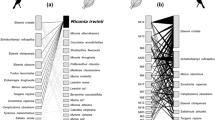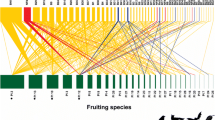Abstract
Fleshy-fruited plants depend fundamentally on interactions with frugivores for effective seed dispersal. Recent models of frugivory within spatially explicit networks make two general predictions regarding these interactions: rate of fruit removal increases (i.e., is facilitated) as densities of conspecific neighborhood fruits increase, and fruit removal rate varies positively with frugivore abundance. We conducted a field experiment that constitutes the first empirical and simultaneous test of these two primary predictions. We manipulated neighborhood abundances of arrowwood (Viburnum recognitum and Viburnum dentatum) fruits in southern New England’s maritime shrub community and monitored removal rates by autumn-migrating birds. Focal arrowwood plants in neighborhoods with high conspecific fruit density sustained moderately decreased fruit removal rates (i.e., competition) relative to those in low-density neighborhoods, a result that agrees with most field research to date but contrasts with theoretical expectation. We suggest the spatial contexts that favor competition (i.e., high-abundance neighborhoods and highly aggregated landscapes) are considerably more common than the relatively uniform, low-aggregation fruiting landscapes that promote facilitation. Patterns of arrowwood removal by avian frugivores generally varied positively with, and apparently in response to, seasonal changes in migratory frugivore abundance. However, we suggest that dense stands of arrowwood concentrated frugivore activity at the neighborhood scale, thus counteracting geographic patterns of frugivore abundance. Our results underscore the importance of considering spatial context (e.g., fruit distribution and aggregation, frugivory hubs) in plant-avian frugivore interactions.





Similar content being viewed by others
References
Able KP (1977) The orientation of passerine nocturnal migrants following offshore drift. Auk 94:320–330
Agrawal AA, Ackerly DD, Adler F, Arnold AE, Cáceres C, Doak DF, Post E, Judson PF, Maron J, Mooney KA, Power M, Schemske D, Stachowicz J, Strauss S, Turner MG, Werner E (2007) Filling key gaps in population and community ecology. Front Ecol Environ 5:145–152. doi:10.2307/20440610
Akaike H (1974) A new look at the statistical model identification. IEEE Trans Autom Contr 19:716–723. doi:10.1109/TAC.1974.1100705
Alerstam T, Lindström Å (1990) Optimal bird migration: the relative importance of time, energy and safety. In: Gwinner E (ed) Bird migration: the physiology and ecophysiology. Springer, New York, pp 331–351
Baird J, Nisbet ICT (1960) Northward fall migration on the Atlantic coast and its relation to offshore drift. Auk 77:119–149
Bates D, Maechler M, Bolker B (2011) lme4: linear mixed-effects models using S4 classes, R Package version 0.999375-42
Blendinger PG, Villegas M (2011) Crop size is more important than neighborhood fruit availability for fruit removal of Eugenia uniflora (Myrtaceae) by bird seed dispersers. Plant Ecol 212:889–899. doi:10.1007/s11258-010-9873-z
Blendinger PG, Loiselle BA, Blake JG (2008) Crop size, plant aggregation, and microhabitat type affect fruit removal by birds from individual melastome plants in the Upper Amazon. Oecologia 158:273–283. doi:10.1007/s00442-008-1146-3
Bolser JA, Alan RA, Smith AD, Li L, Seeram MP, McWilliams SR (2013) Birds select fruits with more anthocyanins and phenolic compounds during autumn migration. Wilson J Ornithol 125:97–108
Borgmann KL, Pearson SF, Levey DJ, Greenberg CH, Stouffer PC (2004) Wintering Yellow-rumped Warblers (Dendroica coronata) track manipulated abundance of Myrica cerifera fruits. Auk 121:74–87. http://dx.doi.org/10.1642/0004-8038(2004)121[0074:WYWDCT]2.0.CO;2
Burnham KP, Anderson DR (2002) Model selection and multimodel inference: a practical information-theoretic approach, 2nd edn. Springer, New York
Carlo TA, Aukema JE (2005) Female-directed dispersal and facilitation between a tropical mistletoe and a dioecious host. Ecology 86:3245–3251. doi:10.1890/05-0460
Carlo TA, Morales JM (2008) Inequalities in fruit-removal and seed dispersal: consequences of bird behaviour, neighbourhood density and landscape aggregation. J Ecol 96:609–618. doi:10.1111/j.1365-2745.2008.01379.x
Carlo TA, Aukema JE, Morales JM (2007) Plant–frugivore interactions as spatially explicit networks: integrating frugivore foraging with fruiting plant spatial patterns. In: Dennis AJ, Schupp EW, Green RJ, Westcott DA (eds) Seed dispersal: theory and its application in a changing world. CAB International, Wallingford, pp 369–390
Carnicer J, Jordano P, Melián CJ (2009) The temporal dynamics of resource use by frugivorous birds: a network approach. Ecology 90:1958–1970. doi:10.1890/07-1939.1
Debussche M, Escarré J, Lepart J (1982) Ornithochory and plant succession in Mediterranean abandoned orchards. Vegetatio 48:255–266. doi:10.1007/BF00055269
Denslow JS (1987) Fruit removal rates from aggregated and isolated bushes of the red elderberry, Sambucus pubens. Can J Bot 65:1229–1235. doi:10.1139/b87-170
Enser RW, Lundgren JA (2006) Natural communities of Rhode Island. Rhode Island Natural History Survey, Kingston
French K, O’Dowd DJ, Lill A (1992) Fruit removal of Coprosma quadrifida (Rubiaceae) by birds in south-eastern Australia. Aust J Ecol 17:35–42. doi:10.1111/j.1442-9993.1992.tb00778.x
García D, Zamora R, Gómez JM, Hódar JA (2001) Frugivory at Juniperus communis depends more on population characteristics than on individual attributes. J Ecol 89:639–647
Gryj EO, Domínguez CA (1996) Fruit removal and postdispersal survivorship in the tropical dry forest shrub Erythroxylum havanense: ecological and evolutionary implications. Oecologia 108:368–374
Harmata AR, Podruzny KM, Zelenak JR, Morrison ML (1999) Using marine surveillance radar to study bird movements and impact assessment. Wildl Soc B 27:44–52. doi:10.2307/3783939
Herrera CM (1984a) Seed dispersal and fitness determinants in wild rose: combined effects of hawthorn, birds, mice, and browsing ungulates. Oecologia 63:386–393
Herrera CM (1984b) A study of avian frugivores, bird-dispersed plants, and their interaction in Mediterranean scrublands. Ecol Monogr 54:2–23. doi:10.2307/1942454
Herrera CM (2002) Seed dispersal by vertebrates. In: Herrera CM, Pellmyr O (eds) Plant–animal interactions: an evolutionary approach, 1st edn. Blackwell, Oxford, pp 185–208
Janzen DH (1971) Seed predation by animals. Annu Rev Ecol Syst 2:465–492. doi:10.2307/2096937
Jordano P (1987) Patterns of mutualistic interactions in pollination and seed dispersal: connectance, dependence asymmetries, and coevolution. Am Nat 129:657–677
Jordano P (1994) Spatial and temporal variation in the avian-frugivore assemblage of Prunus mahaleb: patterns and consequences. Oikos 71:479–491. doi:10.2307/3545836
Jordano P, Bascompte J, Olesen JM (2003) Invariant properties in coevolutionary networks of plant–animal interactions. Ecol Lett 6:69–81
Lambert D (1992) Zero-inflated Poisson regression, with an application to defects in manufacturing. Technometrics 34:1–14
Lázaro A, Mark S, Olesen JM (2005) Bird-made fruit orchards in northern Europe: nestedness and network properties. Oikos 110:321–329
Levey DJ, Moermond TC, Denslow JS (1984) Fruit choice in Neotropical birds: the effect of distance between fruits on preference patterns. Ecology 65:844–850
Levey DJ, Silva WR, Galetti M (2002) Seed dispersal and frugivory: ecology, evolution, and conservation, 1st edn. CABI, New York
Levin SA, Muller-Landau HC, Nathan R, Chave J (2003) The ecology and evolution of seed dispersal: a theoretical perspective. Annu Rev Ecol Evol S 34:575–604. doi:10.2307/30033787
Levine JM, Murrell DJ (2003) The community-level consequences of seed dispersal patterns. Annu Rev Ecol Evol S 34:549–574. doi:10.2307/30033786
Link WA, Barker RJ (2006) Model weights and the foundations of multimodel inference. Ecology 87:2626–2635
Manasse RS, Howe HF (1983) Competition for dispersal agents among tropical trees: influences of neighbors. Oecologia 59:185–190
Martin TG, Wintle BA, Rhodes JR, Kurner PM, Field SA, Low-Choy SJ, Tyre AJ, Possingham HP (2005) Zero tolerance ecology: improving ecological inference by modelling the source of zero observations. Ecol Lett 8:1235–1246
Mizrahi D, Fogg R, Magarian T, Elia V, Jodgetts P, La Puma D (2010) Radar monitoring of bird and bat movement patterns on Block Island and its coastal waters. In: McCann J et al. (eds) Ocean Special Area Management Plan. Technical report 11, appendix K. University of Rhode Island, Narragansett.
Moegenburg SM, Levey DJ (2003) Do frugivores respond to fruit harvest? An experimental study of short-term responses. Ecology 84:2600–2612. doi:10.2307/3450106
Moore LA, Willson MF (1982) The effect of microhabitat, spatial distribution, and display size on dispersal of Lindera benzoin by avian frugivores. Can J Bot 60:557–560
Morales JM, Carlo TA (2006) The effects of plant distribution and frugivore density on the scale and shape of dispersal kernels. Ecology 87:1489–1496
Morales JM, Vázquez DP (2008) The effect of space in plant–animal mutualistic networks: insights from a simulation study. Oikos 117:1362–1370. doi:10.1111/j.2008.0030-1299.16737.x
Muller-Landau HC, Wright SJ, Calderón O, Condit R, Hubbell SP (2008) Interspecific variation in primary seed dispersal in a tropical forest. J Ecol 96:653–667. doi:10.1111/j.1365-2745.2008.01399.x
Parrish JD (1997a) Frugivory during autumn migration in Nearctic-Neotropical migrant landbirds: patterns, causes, and consequences. PhD dissertation, Department of Ecology and Evolution, Brown University
Parrish JD (1997b) Patterns of frugivory and energetic condition in Nearctic landbirds during autumn migration. Condor 99:681–697
Parrish JD (2000) Behavioral, energetic, and conservation implications of foraging plasticity during migration. Stud Avian Biol 20:53–70
Pizo MA, Almeida-Neto M (2009) Determinants of fruit removal in Geonoma pauciflora, an understory palm of neotropical forests. Ecol Res 24:1179–1186. doi:10.1007/s11284-009-0599-0
R Development Core Team (2011) R: a language and environment for statistical computing. R Foundation for Statistical Computing, Vienna
Reinert SE, Lapham E, Gaffett K (2002) Landbird migration on Block Island: community composition and conservation implications for an island stopover habitat. In: Paton PW, Gould LL, August PV, Frost AO (eds) The ecology of Block Island. The Rhode Island Natural History Survey, Kingston, pp 151–168
Rey PJ (1995) Spatio-temporal variation in fruit and frugivorous bird abundance in olive orchards. Ecology 76:1625–1635. doi:10.2307/1938163
Richards SA (2005) Testing ecological theory using the information-theoretic approach: examples and cautionary results. Ecology 86:2805–2814
Russo SE, Portnoy S, Augspurger CK (2006) Incorporating animal behavior into seed dispersal models: implications for seed shadows. Ecology 87:3160–3174. http://dx.doi.org/10.1890/0012-9658(2006)87[3160:IABISD]2.0.CO;2
Saracco JF, Collazo JA, Groom MJ (2004) How do frugivores track resources? Insights from spatial analyses of bird foraging in a tropical forest. Oecologia 139:235–245. doi:10.1007/s00442-004-1493-7
Saracco JF, Collazo JA, Groom MJ, Carlo TA (2005) Crop size and fruit neighborhood effects on bird visitation to fruiting Schefflera morototoni trees in Puerto Rico. Biotropica 37:81–87
Sargent S (1990) Neighborhood effects on fruit removal by birds: a field experiment with Viburnum dentatum (Caprifoliaceae). Ecology 71:1289–1298
Schupp EW (1993) Quantity, quality and the effectiveness of seed dispersal by animals. Plant Ecol 107–108:15–29. doi:10.1007/BF00052209
Schupp EW, Jordano P, Gómez JM (2010) Seed dispersal effectiveness revisited: a conceptual review. New Phytol 188:333–353. doi:10.1111/j.1469-8137.2010.03402.x
Skaug H, Fournier D, Nielsen A, et al. (2012) glmmADMB: generalized linear mixed models using AD Model Builder. R package version 0.7.2.5/r186
Smith SB, McWilliams SR (2010) Patterns of fuel use and storage in migrating passerines in relation to fruit resources at autumn stopover sites. Auk 127:108–118. doi:10.1525/auk.2009.09139
Smith SB, McPherson KH, Backer JM, Pierce BJ, Podlesak DW, McWilliams SR (2007) Fruit quality and consumption by songbirds during autumn migration. Wilson J Ornithol 119:419–428
Svedlow AB, Gilpatrick L, Agius B, Andrews M, Myers P (2012) Pre-construction avian and bat assessment: 2009-2011. In: Tetra Tech (ed) Block Island Wind Farm and Block Island Transmission System environmental report/construction and operations plan. Deepwater Wind, Boston (Appendix O)
Takahashi K, Kamitani T (2004) Factors affecting seed rain beneath fleshy-fruited plants. Plant Ecol 174:247–256
Thompson JN, Willson MF (1979) Evolution of temperate fruit/bird interactions: phenological strategies. Evolution 33:973–982
Van Ommeren RJ, Whitham TG (2002) Changes in interactions between juniper and mistletoe mediated by shared avian frugivores: parasitism to potential mutualism. Oecologia 130:281–288
Acknowledgments
Thanks to the fine assistance of two dedicated field crews, including B. Jones, R. Alan, S. Bebus, K. Chmiel, J. Cressman, L. Jenkins, and E. Pokrivka. S. Comings and The Nature Conservancy graciously accommodated field staff and provided property access and logistical support on Block Island. New Shoreham Town Manager N. Dodge facilitated access to town property. Doug Levey and four anonymous reviewers provided valuable criticisms of earlier drafts. This work was funded by the National Science Foundation (IBN-9984920, IOS-0748349), Rhode Island Agricultural Experiment Station (contribution no. 5350), and the U.S. Department of Agriculture (538748) to S. McWilliams and a Nature Conservancy grant to A. Smith. The experiments comply with the current laws of the United States of America.
Author information
Authors and Affiliations
Corresponding author
Additional information
Communicated by Ines Ibanez.
Electronic supplementary material
Below is the link to the electronic supplementary material.
Rights and permissions
About this article
Cite this article
Smith, A.D., McWilliams, S.R. Fruit removal rate depends on neighborhood fruit density, frugivore abundance, and spatial context. Oecologia 174, 931–942 (2014). https://doi.org/10.1007/s00442-013-2834-1
Received:
Accepted:
Published:
Issue Date:
DOI: https://doi.org/10.1007/s00442-013-2834-1




